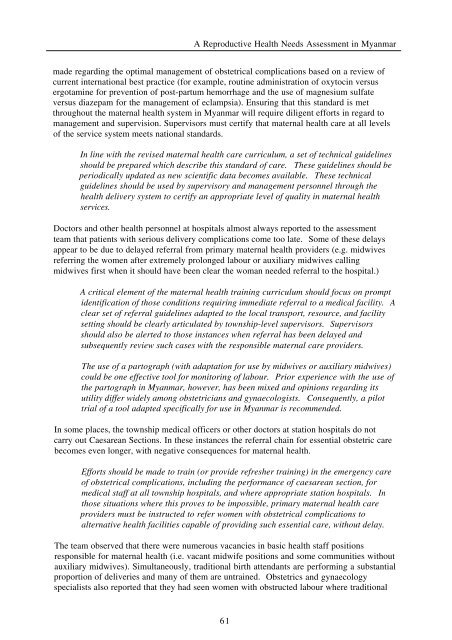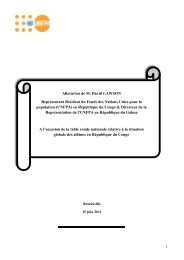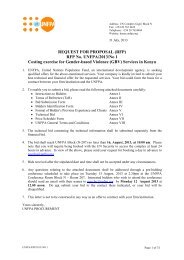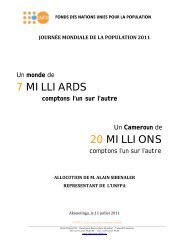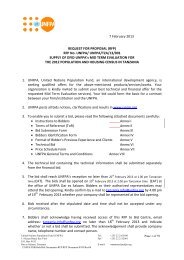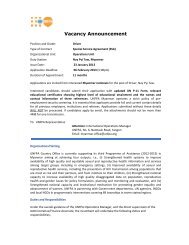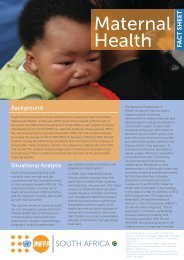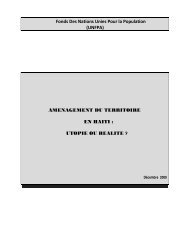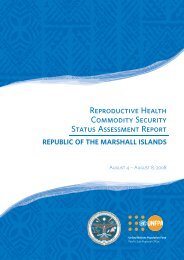A reproductive health needs assessment in Myanmar
A reproductive health needs assessment in Myanmar
A reproductive health needs assessment in Myanmar
You also want an ePaper? Increase the reach of your titles
YUMPU automatically turns print PDFs into web optimized ePapers that Google loves.
A Reproductive Health Needs Assessment <strong>in</strong> <strong>Myanmar</strong><br />
made regard<strong>in</strong>g the optimal management of obstetrical complications based on a review of<br />
current <strong>in</strong>ternational best practice (for example, rout<strong>in</strong>e adm<strong>in</strong>istration of oxytoc<strong>in</strong> versus<br />
ergotam<strong>in</strong>e for prevention of post-partum hemorrhage and the use of magnesium sulfate<br />
versus diazepam for the management of eclampsia). Ensur<strong>in</strong>g that this standard is met<br />
throughout the maternal <strong>health</strong> system <strong>in</strong> <strong>Myanmar</strong> will require diligent efforts <strong>in</strong> regard to<br />
management and supervision. Supervisors must certify that maternal <strong>health</strong> care at all levels<br />
of the service system meets national standards.<br />
In l<strong>in</strong>e with the revised maternal <strong>health</strong> care curriculum, a set of technical guidel<strong>in</strong>es<br />
should be prepared which describe this standard of care. These guidel<strong>in</strong>es should be<br />
periodically updated as new scientific data becomes available. These technical<br />
guidel<strong>in</strong>es should be used by supervisory and management personnel through the<br />
<strong>health</strong> delivery system to certify an appropriate level of quality <strong>in</strong> maternal <strong>health</strong><br />
services.<br />
Doctors and other <strong>health</strong> personnel at hospitals almost always reported to the <strong>assessment</strong><br />
team that patients with serious delivery complications come too late. Some of these delays<br />
appear to be due to delayed referral from primary maternal <strong>health</strong> providers (e.g. midwives<br />
referr<strong>in</strong>g the women after extremely prolonged labour or auxiliary midwives call<strong>in</strong>g<br />
midwives first when it should have been clear the woman needed referral to the hospital.)<br />
A critical element of the maternal <strong>health</strong> tra<strong>in</strong><strong>in</strong>g curriculum should focus on prompt<br />
identification of those conditions requir<strong>in</strong>g immediate referral to a medical facility. A<br />
clear set of referral guidel<strong>in</strong>es adapted to the local transport, resource, and facility<br />
sett<strong>in</strong>g should be clearly articulated by township-level supervisors. Supervisors<br />
should also be alerted to those <strong>in</strong>stances when referral has been delayed and<br />
subsequently review such cases with the responsible maternal care providers.<br />
The use of a partograph (with adaptation for use by midwives or auxiliary midwives)<br />
could be one effective tool for monitor<strong>in</strong>g of labour. Prior experience with the use of<br />
the partograph <strong>in</strong> <strong>Myanmar</strong>, however, has been mixed and op<strong>in</strong>ions regard<strong>in</strong>g its<br />
utility differ widely among obstetricians and gynaecologists. Consequently, a pilot<br />
trial of a tool adapted specifically for use <strong>in</strong> <strong>Myanmar</strong> is recommended.<br />
In some places, the township medical officers or other doctors at station hospitals do not<br />
carry out Caesarean Sections. In these <strong>in</strong>stances the referral cha<strong>in</strong> for essential obstetric care<br />
becomes even longer, with negative consequences for maternal <strong>health</strong>.<br />
Efforts should be made to tra<strong>in</strong> (or provide refresher tra<strong>in</strong><strong>in</strong>g) <strong>in</strong> the emergency care<br />
of obstetrical complications, <strong>in</strong>clud<strong>in</strong>g the performance of caesarean section, for<br />
medical staff at all township hospitals, and where appropriate station hospitals. In<br />
those situations where this proves to be impossible, primary maternal <strong>health</strong> care<br />
providers must be <strong>in</strong>structed to refer women with obstetrical complications to<br />
alternative <strong>health</strong> facilities capable of provid<strong>in</strong>g such essential care, without delay.<br />
The team observed that there were numerous vacancies <strong>in</strong> basic <strong>health</strong> staff positions<br />
responsible for maternal <strong>health</strong> (i.e. vacant midwife positions and some communities without<br />
auxiliary midwives). Simultaneously, traditional birth attendants are perform<strong>in</strong>g a substantial<br />
proportion of deliveries and many of them are untra<strong>in</strong>ed. Obstetrics and gynaecology<br />
specialists also reported that they had seen women with obstructed labour where traditional<br />
61


